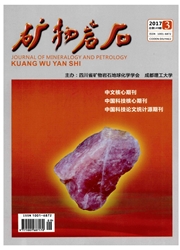

 中文摘要:
中文摘要:
通过对苏里格气田北部盒8、山1段24口钻井572块样品的成岩作用研究表明,苏里格气田北部盒8和山1段主要经历了压实作用、胶结作用、次生加大作用、自生矿物的生成、交代和蚀变作用、溶蚀作用、破裂作用等。根据它们对孔隙发育的贡献分为建设性成岩作用、破坏性成岩作用、保持性成岩作用3种类型。其中,约80%的砂岩粒间孔具有溶蚀现象,溶蚀作用使储集层孔隙结构得到有效的改善,以次生粒间孔最为常见,粒内溶孔较少见,粘土质微孔发育,并与岩石中保存下来的剩余原生粒间孔组合构成溶孔-原生粒间孔组合、溶孔-粘土质微孔组合及溶孔-微孔-(裂缝、粒缘缝)组合。保持性成岩作用所生成的环边绿泥石包膜使部分孔隙得以保存,对储层的发育具有积极意义。根据铸体薄片、扫描电镜下所观察到的自生矿物类型以及X衍射等测试手段所揭示的I/S混层粘土矿物的演变、粘土矿物组合及矿物中的混层比,这些成岩作用被划分为早成岩A期、旱成岩B期、中成岩A期、中成岩B期和晚成岩期3个阶段5个期次;成岩作用研究认为S4井,S5井,S6井和T5井区为有利储层分布区。
 英文摘要:
英文摘要:
Study on the characteristics of diagenesis shows that He8 and Shanl Member in the north of Sulige gas field has undergone compaction, cementation, secondary enlargement, authigenic mineral-producing, metasomatic alteration, dissolution, as well as fracturing processes respectively. According to their contribution to pores, diagenesis can be divided into three types, constructive, destructive and retention processes. Compaction process resulted in sharp reduction of 20%-25% in pore. Corrosion occurred in about 80% sand pore,which is the most important factor for the improvement of reservoir pore structure. Secondary intergranular pore is common, but intergranular corrosive pore is seldom. The well-developed clay micropore and residual intergranular pore form several combinations. In retention processes, the grain-coating of lining chlorite resulted in the preservation of some pores and has positive meanings for reservoir development. Based on the observation of cores and slices and application of SEM/CL and X ray diffraction technology,combined with the types of authigenic mineral, formation temperature, producing order, relative order of the diagenetic evolution of various minerals, the structure and texture characteristics of the clastic and interstitial material,and I/S clay mineral evolution, these diagenesis were divided into 3 stages and 5 phases,including A and B the second phase of early diagenesis,A and B the second phase of middle diagenesis, and late diagenesis. The area of S4, S5, S6 and T5 are considered to be favorable reservoir position according to the diagenetic study.
 同期刊论文项目
同期刊论文项目
 同项目期刊论文
同项目期刊论文
 期刊信息
期刊信息
